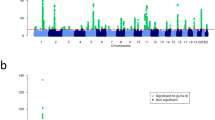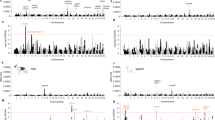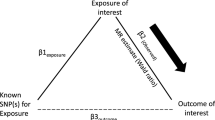Abstract
Atopic dermatitis (eczema) is a chronic inflammatory skin disease with onset mainly in early childhood1. It is commonly the initial clinical manifestation of allergic disease, often preceding the onset of respiratory allergies2,3. Along with asthma and allergic rhinitis, atopic dermatitis is an important manifestation of atopy that is characterized by the formation of allergy antibodies (IgE) to environmental allergens. In the developed countries, the prevalence of atopic dermatitis is approximately 15%, with a steady increase over the past decades4,5. Genetic and environmental factors interact to determine disease susceptibility and expression6, and twin studies indicate that the genetic contribution is substantial7. To identify susceptibility loci for atopic dermatitis, we ascertained 199 families with at least two affected siblings based on established diagnostic criteria8,9. A genome-wide linkage study revealed highly significant evidence for linkage on chromosome 3q21 (Zall=4.31, P= 8.42×10−6). Moreover, this locus provided significant evidence for linkage of allergic sensitization under the assumption of paternal imprinting (hlod=3.71, α=44%), further supporting the presence of an atopy gene in this region. Our findings indicate that distinct genetic factors contribute to susceptibility to atopic dermatitis and that the study of this disease opens new avenues to dissect the genetics of atopy.
This is a preview of subscription content, access via your institution
Access options
Subscribe to this journal
Receive 12 print issues and online access
$209.00 per year
only $17.42 per issue
Buy this article
- Purchase on Springer Link
- Instant access to full article PDF
Prices may be subject to local taxes which are calculated during checkout


Similar content being viewed by others
References
Hanifin, J.M. Atopic Dermatitis (Mosby, St. Louis, 1998).
Bergmann, R.L. et al. Atopic dermatitis in early infancy predicts allergic airway disease at 5 years. Clin. Exp. Allergy 28, 965–970 (1998).
Cox, H.E. et al. Association of atopic dermatitis to the β subunit of the high affinity immunoglobulin E receptor. Br. J. Dermatol. 138, 182–187 (1998).
Kay, J., Gawkrodger, D.J., Mortimer, M.J. & Jaron, A.G. The prevalence of childhood atopic eczema in a general population. J. Am. Acad. Dermatol. 30, 35–39 (1994).
Taylor, B., Wadsworth, J., Wadsworth, M. & Peckham, C. Changes in the reported prevalence of childhood eczema since the 1939–45 war. Lancet 2, 1255–1257 (1984).
Cookson, W. The alliance of genes and environment in asthma and allergy. Nature 402, B5–11 (1999).
Larsen, F.S., Holm, N.V. & Henningsen, K. Atopic dermatitis. A genetic-epidemiologic study in a population-based twin sample. J. Am. Acad. Dermatol. 15, 487–494 (1986).
Hanifin, J.M. & Rajka, G. Diagnostic features of atopic dermatitis. Acta Derm. (Stockh.) 92, 44–47 (1980).
Leung, D.Y. et al. Disease management of atopic dermatitis: a practice parameter. Joint Task Force on Practice Parameters, representing the American Academy of Allergy, Asthma and Immunology, the American College of Allergy, Asthma and Immunology, and the Joint Council of Allergy, Asthma and Immunology. Work Group on Atopic Dermatitis. Ann. Allergy Asthma Immunol. 79, 197–211 (1997).
Daniels, S.E. et al. A genome-wide search for quantitative trait loci underlying asthma. Nature 383, 247–250 (1996).
The Collaborative Study on the Genetics of Asthma (CSGA). A genome-wide search for asthma susceptibility loci in ethnically diverse populations. Nature Genet. 15, 389–392 (1997).
Ober, C. et al. Genome-wide search for asthma susceptibility loci in a founder population. The Collaborative Study on the Genetics of Asthma. Hum. Mol. Genet. 7, 1393–1398 (1998).
Wjst, M. et al. A genome-wide search for linkage to asthma. German Asthma Genetics Group. Genomics 58, 1–8 (1999).
Kunz, B. et al. Clinical validation and guidelines for the SCORAD index: consensus report of the European Task Force on Atopic Dermatitis. Dermatology 195, 10–19 (1997).
Dold, S., Wjst, M., von Mutius, E., Reitmeir, P. & Stiepel, E. Genetic risk for asthma, allergic rhinitis, and atopic dermatitis. Arch. Dis. Child. 67, 1018–1022 (1992).
Mao, X.Q. et al. Association between genetic variants of mast-cell chymase and eczema. Lancet 348, 581–583 (1996).
Hershey, G.K., Friedrich, M.F., Esswein, L.A., Thomas, M.L. & Chatila, T.A. The association of atopy with a gain-of-function mutation in the α subunit of the interleukin-4 receptor. N. Engl. J. Med. 337, 1720–1725 (1997).
Nickel, R.G. et al. Atopic dermatitis is associated with a functional mutation in the promoter of the C-C chemokine RANTES. J. Immunol. 164, 1612–1616 (2000).
Abreu, P.C., Greenberg, D.A. & Hodge, S.E. Direct power comparisons between simple LOD scores and NPL scores for linkage analysis in complex diseases. Am. J. Hum. Genet. 65, 847–857 (1999).
Moffatt, M.F. & Cookson, W.O. The genetics of asthma. Maternal effects in atopic disease. Clin. Exp. Allergy 28, 56–61 (1998).
Kuchroo, V.K. et al. B7-1 and B7-2 costimulatory molecules activate differentially the Th1/Th2 developmental pathways: application to autoimmune disease therapy. Cell 80, 707–718 (1995).
Lanier, L.L. et al. CD80 (B7) and CD86 (B70) provide similar costimulatory signals for T cell proliferation, cytokine production, and generation of CTL. J. Immunol. 154, 97–105 (1995).
Dib, C. et al. A comprehensive genetic map of the human genome based on 5,264 microsatellites. Nature 380, 152–154 (1996).
O'Connell, J.R. & Weeks, D.E. PedCheck: a program for identification of genotype incompatibilities in linkage analysis. Am. J. Hum. Genet. 63, 259–266 (1998).
Kruglyak, L., Daly, M.J., Reeve-Daly, M.P. & Lander, E.S. Parametric and nonparametric linkage analysis: a unified multipoint approach. Am. J. Hum. Genet. 58, 1347–1363 (1996).
Conneally, P.M. et al. Report of the Committee on Methods of Linkage Analysis and Reporting. Cytogenet. Cell Genet. 40, 356–359 (1985).
Kong, A. & Cox, N.J. Allele-sharing models: LOD scores and accurate linkage tests. Am. J. Hum. Genet. 61, 1179–1188 (1997).
Strauch, K. et al. Parametric and nonparametric multipoint linkage analysis with imprinting and two-locus-trait models: application to mite sensitization. Am. J. Hum. Genet. 66, 1945–1957 (2000).
Gudbjartsson, D.F., Jonasson, K., Frigge, M.L. & Kong, A. Allegro, a new computer program for multipoint linkage analysis. Nature Genet. 25, 12–13 (2000).
Lander, E. & Kruglyak, L. Genetic dissection of complex traits: guidelines for interpreting and reporting linkage results. Nature Genet. 11, 241–247 (1995).
Acknowledgements
We thank the families for participation; R. Nickel for help in initiating this project; M. Schwarz for technical assistance; T. Jakob and R. Mayrl for help with family recruitment; and G. Nürnberg for preparing the figures. This work was supported by Bundesministerium für Forschung und Technologie and the German Human Genome Project.
Author information
Authors and Affiliations
Corresponding authors
Rights and permissions
About this article
Cite this article
Lee, YA., Wahn, U., Kehrt, R. et al. A major susceptibility locus for atopic dermatitis maps to chromosome 3q21. Nat Genet 26, 470–473 (2000). https://doi.org/10.1038/82625
Received:
Accepted:
Issue Date:
DOI: https://doi.org/10.1038/82625
This article is cited by
-
Immunsystem und Allergien – eine unheilige Allianz
Der Internist (2022)
-
Gründe für die Entstehung von Allergien bei Kindern
HNO (2019)
-
Identification of novel candidate variants including COL6A6 polymorphisms in early-onset atopic dermatitis using whole-exome sequencing
BMC Medical Genetics (2017)
-
Molecular Biology of Atopic Dermatitis
Clinical Reviews in Allergy & Immunology (2014)
-
Epidermal Barrier Dysfunction in Atopic Dermatitis
Journal of Investigative Dermatology (2009)



